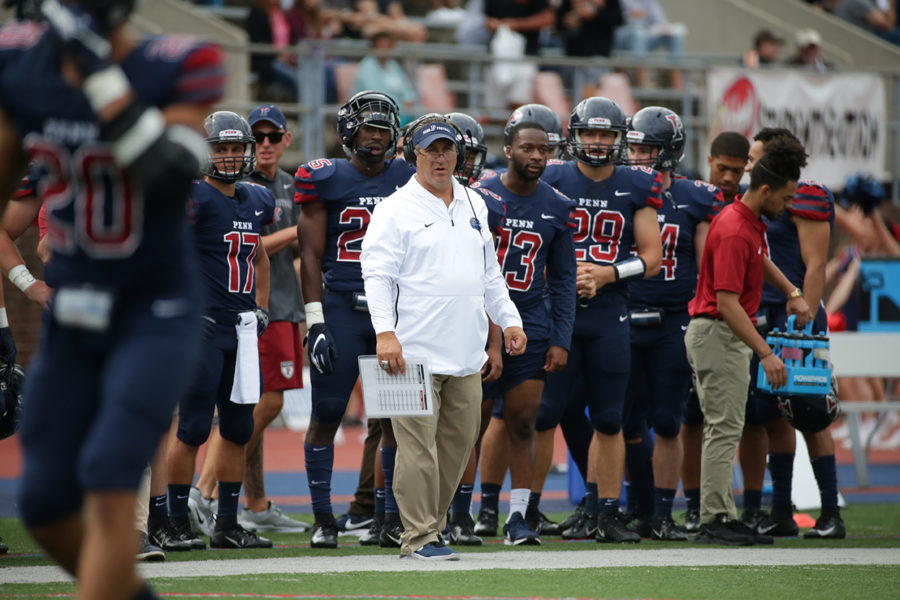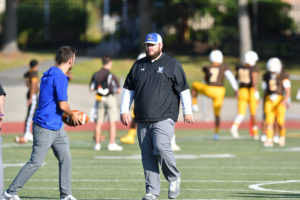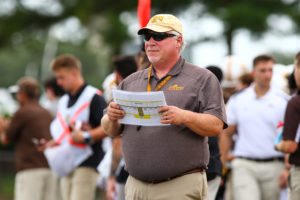
180906 University of Pennsylvania - Football vs Lehigh at Franklin Field

Zwaan
In early August, as West Chester football coach Bill Zwaan prepared to leave the house on the first day of coaches’ meetings before fall practice began, his wife, Rosemary, had a question for him. “Are you ready for this?” she wanted to know.
Zwaan answered quickly. “Yes.”
“So am I!” she said.
After more than a year of coping with a disrupted football calendar that scrubbed the 2020 campaign from the Rams, Zwaan was delighted to be returning to normal. He and his coaches would gather to plan the pre-season. Players would then report. Finally, everybody would take the field in preparation for West Chester University’s season opener, a September 3 visit to Boston to take on Bentley College.
Zwaan has been coaching for more than four decades, and his competitive fire still rages, but he’s so happy to be back coaching again—and not managing a program remotely—that wins and losses might be secondary to the overall experience of playing football once again.
“From a coaching standpoint, we are so methodical,” Zwaan says. “Do this at this time on this day. During the year-and-half we lost, we haven’t had that regimen. For 40-plus years, I have been getting up at the same time every day.
“The person most happy that I am back to football is my wife. I’ve been driving her crazy.”
Coaches across the area felt the same way Zwaan did as the 2021 season dawned. Other than Temple, which played seven games last fall, and Villanova, which was able to play four games last spring, college programs idled anxiously during the 2020 season, as their schools kept students away from campus or shut down athletic programs for those who were able to show up. Like everything else that dominated the world from March 2020 until this spring, when vaccinations helped the Philadelphia region come back to life, it was unprecedented. And nobody liked it.
“When you’ve done it as long as most coaches have done it, from Pop Warner on up, football starts in August,” University of Pennsylvania coach Ray Priore says. “That’s how our mental clocks work. It was very different not playing. We had to occupy ourselves with a lot of different things.
“It wasn’t natural. Our job is to work with kids and keep them together and focused. I watched a lot of football, which I never get a chance to do. I got a chance to see my family, which I don’t get a chance to do during the season. There were a lot of lessons learned. My biggest bit of gratitude from the process was realizing what we once had when we didn’t have it.”
They have it now. Across the region, Saturdays (and some Thursdays and Fridays) will mean college football. It’s a great thing for fans. It’s huge for students who go to games. And it’s a major step forward for the players and coaches who spent much of the past 18 months cobbling together workouts and meetings in order to maintain a sense of that order that Zwaan and Priore mentioned. Now that everybody is back on the practice fields and in the stadiums, the autumn continuum is intact and natural once again.
“Tons of kids on my team need football desperately,” Zwaan says. “They relate to themselves and others as football players, and that’s what they think of themselves, and what their families think of them. They’re not the same people without it. It helps them, on and off the field.
“It is an identity for them.”
Of course, things won’t be completely normal. The rising Covid-19 cases across the area and—especially—the nation mean teams must continue to observe protocols moving forward. For Mike Barainyak at Widener University, that’s not the worst thing. Now in his third year leading the Pride, Barainyak preaches the importance of sacrifice to his players. That means thinking about the team on and off the field.

Barainyak
“This is part of the program,” he says. “If you want to be a successful football team, you have to sacrifice to make everyone successful.
“You may be a linebacker, but it might be best for the team to play fullback or defensive end. Will you make the sacrifice for the team? We fold this into the program. If you want to come to Widener and get a degree, you need to sacrifice in the classroom. If you want to play 10 games this year, you’re going to wear a mask. We want everybody to stay safe.”
Wearing masks and going through other potentially uncomfortable protocols will be a heckuva lot better than what programs endured last year when most were informed in the late spring and summer that there would be no season. Trying to keep teams together through remote meetings and working to come up with workout and training plans players could execute on their own was frustrating at best and maddening at worst.
At Rowan University, coach Jay Accorsi and his staff were able to conduct some “workouts” in the fall, without pads and with the players six feet apart. That’s not exactly conducive to teaching blocking and tackling. But at least the Profs were able to gather and keep some sense of team unity. When the team was able to have spring practices, it was quite clear the team had been away from the sport for quite a while.

Accorsi
“It was drastic,” Accorsi says. “Everything we did was different. It was evident for those who had been away from football for a year that they were really rusty. Some of the high school students who came to campus early had a fall season.
“Obviously, in terms of being in shape and with football skills, you could tell most of them hadn’t done a thing for a year, in terms of real football.”
Other area coaches experienced similar conditions from their players during their spring drills. Few had the opportunity—thanks to restrictions by their universities—to do what was necessary in order to be ready to play ball. At Penn, the Quakers went through 12 practices and then had a spring game. Before a player stepped on the field, though, Priore and his staff spoke with coaches at schools that had fall seasons, but no summer programs.
They found that there was a disproportionate amount of muscle pulls and other soft-tissue injuries because players hadn’t had the opportunity to maintain the kind of conditioning they need to go all-out on the football field. That information led to a change in focus during the spring.
“We crawled, then we walked, then we jogged, then we ran,” Priore says. “We took it slow. Fortunately, we had a very, very limited number of pulls.”
The good news for teams during the 2021 season is they had the opportunity to have workouts this summer—for those schools whose players stay on campus. Those players who headed home had access to gyms, high school weight rooms and other facilities that would allow them to come back for the start of fall practice in good shape. It’s hard to know what will happen in the coming months, but everybody is happy to be back to something of a normal football season.
“My goal is to put a team together that is competitive,” Accorsi says.
That’s the mantra of just about all coaches across the country as they enter what they hope will be a relatively ordinary season. They have made it through the pandemic isolation, worked extremely hard to maintain team unity and did whatever they could to prepare teams for the upcoming season. As games continue, and the focus is on how the offense is performing and if the defense can stand up to opposing attacks, the memories of last season will fade, even if there are still some lingering effects.
“It has been a slow build back,” Priore says. “It has given us optimism. Our kids treated every moment since February 1st with great excitement. We couldn’t have done it if the kids weren’t passionate about playing. They love what they do.
“The whole spring was like that. It was like a three-month birthday party. The players worked hard, but there was gratitude. We were able to build our team and our culture and get back to what’s normal.”
Back to football.
Photos courtesy of: West Chester University, Widener University, University of Pennsylvania, and Rowan University.

